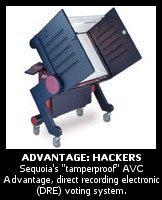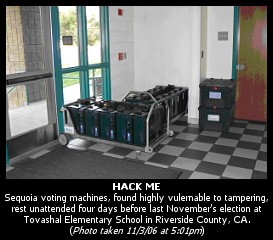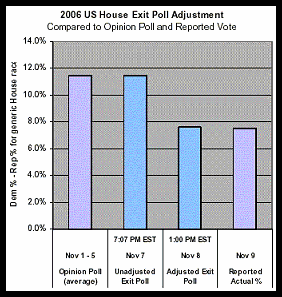BIPARTISANLY YOURS: COAKLEY WON THE HAND COUNTS
Posted in Bev Harris, Black Box (Electronic) Voting on January 20th, 2010This article is about our right to know, not about Martha Coakley or Scott Brown. And lest you think something here favors a Democrat, just you wait, I’m still working on anomalies in the NY-23 election that are just plain hard to ‘splain. As Richard Hayes Phillips says when people tell him to forget it, “I’m a historian, I’ve got all the time in the world.” NY-23 still has history to be written. My public records are starting to arrive. But that’s another story.
Back to Massachusetts, I think you have a right to know that Coakley won the hand counts there. You can discuss this here:
http://www.bbvforums.org/forums/messages/8/80830.html
That’s right.
According to preliminary media results by municipality, Democrat Martha Coakley won Massachusetts overall in its hand counted locations,* with 51.12% of the vote (32,247 hand counted votes) to Brown’s 30,136, which garnered him 47.77% of hand counted votes. Margin: 3.35% lead for Coakley.
Massachusetts has 71 hand count locations, 91 ES&S locations, and 187 Diebold locations, with two I call the mystery municipalities (Northbridge and Milton) apparently using optical scanners, not sure what kind.
ES&S RESULTS
The greatest margin between the candidates was with ES&S machines — 53.64% for Brown, 45.31% for Coakley, a margin for Brown of 8.33%. It looks like ES&S counted a total of 620,388 votes, with 332,812 going to Brown and 281,118 going to Coakley. Taken overall, the difference — 8.33% Brown (ES&S) added to 3.35% Coakley (Hand Count) shows an 11.68% difference between the ES&S and the Hand Counts. Of course, as Mark Twain used to say, there are three kinds of lies: Lies, damned lies, and statistics. These statistics don’t prove anything, and probably shouldn’t be discussed without a grain of salt handy before examining more detailed demographics.
As a point of reference, however, in the Maine gay marriage issue recently there was no significant overall difference between machine count and hand count locations.
DIEBOLD RESULTS
Diebold’s results are 51.42% for Brown, with 791,272 Republican votes counted by Diebold, vs. 47.61% for Coakley, with 732,633 Democratic votes counted by Diebold, for a spread of 3.81% favoring Brown.
LATE-REPORTED RESULTS
It’s always interesting to watch hand counts beat machine count results to the newspaper.
In the Massachusetts special senate election, results from six of 71 hand count locations were reported about 2 1/2 hours after the polls closed, with the remaining 65 hand count locations in right away. The slower hand count results represent 8.45% of all hand count locations.
These latecoming hand-counted results favored Coakley very heavily (she got 55.68% of these, earning 4,610 votes to Brown’s 42.9%, representing 3,552, a 12.78% margin) Whether the reports came to the media late or the media posted them late is unclear.
ES&S SLOWPOKE VOTES
ES&S had 12 of its 91 locations reported at least 2 1/2 hours after polls closed, a total of 13.2% of all its locations (as compared with just 8.45% of slower reporting hand count locations). So ES&S certainly wasn’t faster than hand counts, overall!
These slow-arriving votes represented 88,288 of ES&S’s 620,388 votes. Overall Brown got 46,257, for 52.39% of the late-arriving ES&S votes, and Coakley got 41,238, for 46.71%, yielding a margin of 5.68% of the late-arriving votes going to Brown, for a net gain of 5,019 votes to Brown.
North Attleboro and Paxton appear to be the last locations in the state to be reported, and they are both ES&S. North Attleboro brought in 10,881
very late votes, 71.48% of them going to Brown; Paxton brought in 2,036 votes, 65.37% going to Brown.
THE SLOW BOAT FROM DIEBOLD
Yes, I know they’re supposed to be called Premier machines now, and ES&S bought the company so it’s now all one big monopoly family, and then the whole kit and kaboodle in New England — Premier and ES&S — is programmed by the juicy little LHS Associates guys. But I like to just call them Diebold, that familiar name which we all know and love.
Twenty-four of Diebold’s 187 locations wandered in late, smoking cigarettes and wearing a bathrobe. That’s 12.83% of all its locations. Apparently it was faster to hand count 8,497 ballots, as they did promptly in Newburyport, or 7,339 ballots, as they hand counted in public for all to see in Milton, than to push a button and wait five minutes for the machine to spit out a Diebold results report in Pelham where they had 725 votes. East Brookfield’s 899 Diebold votes must have run out of gas somewhere; they weren’t reported for hours.
All in all, a total of 170,594 Diebold votes took a long time to stumble in the door, These votes — surprise! — favored Coakley. She got 86,214 of them, for 50.54%, and Brown got 82,911 tardy Diebold votes, for 48.60%, putting Coakley on the plus side of the late arrivers by a 1.94% margin, for a net gain of 3,303 slow-moving votes.
They’d called the election by the time the 170,594 tardy Diebold votes showed up. Coakley had conceded. And of course, there are many ways to look at this if you don’t trust voting machines, and why should you? It’s hard to know who was fooling around, or if anybody was.
You see, the Diebold latecomers represented the strongest showing for Coakley of all and in some heavily populated areas. 32 of 33 Cambridge polling place results couldn’t find their way to the media for a long time. Cambridge finally came in with 27,268 votes for Coakley — 84.11%. Brown was only able to locate 4,921 votes from Cambridge when all was said and done.
And the media couldn’t seem to rustle up any Amherst votes for any of its 10 polling places until races were called and candidates had conceded. Amherst generated 84% of its votes for Coakley with only 15% going to Brown.
So this is all very interesting, and hopefully is accurate because I’m spreadsheeting after midnight. And we’re talking statistics based on premature and unofficial results which came from the media and not the government, and the Massachusetts Secretary of State doesn’t officially tell us which place is using which system, so we’re relying on volunteers from the VerifiedVoting Web site who hunted it down.**
** A public service announcement from Disclaimers-R-Us, a subsidiary of the US Elections Industry.
GET OVER IT, SCOTT BROWN WON
Actually, I think any intellectually honest person will see that Brown garnered financing and executed brilliantly, and that’s just politics.
He probably DID win. In 71 Massachusetts locations we could watch the counting (woops, he lost those, overall). But in 277 locations, the counting was on computerized voting machines and concealed from the public.
So we can never really know who won, and that is unfair to both Scott Brown and Martha Coakley. But it’s most unfair to the citizens of Massachusetts, who have an inalienable right to choose their own governance. You can’t hold sovereignty over the choosing process if you can’t see it.
Black Box Voting is a national, nonpartisan, nonprofit 501c(3) elections watchdog organization. We need your support in 2010 very much. If you think our work is important, do support us.
Just click here: http://www.blackboxvoting.org/donate.html
or mail to:
Black Box Voting
330 SW 43rd St Suite K
PMB 547
Renton WA 98057
This message was sent by: Black Box Voting, Inc., 330 SW 43rd St Suite K – PMB 547, Renton, WA 98057



 In the same report, it was revealed that an attorney has filed suit, claiming the Sequoia AVC Advantage Direct Recording Electronic (DRE) voting machines used in 18 of New Jersey’s 21 counties were never reviewed by the state before they were improperly certified for use and that Princeton’s Appel was able to acquire five Sequoia voting machines for only $86. The same machines were recently purchased by the state for $8,000 apiece.
In the same report, it was revealed that an attorney has filed suit, claiming the Sequoia AVC Advantage Direct Recording Electronic (DRE) voting machines used in 18 of New Jersey’s 21 counties were never reviewed by the state before they were improperly certified for use and that Princeton’s Appel was able to acquire five Sequoia voting machines for only $86. The same machines were recently purchased by the state for $8,000 apiece.
 Venetis argues that the state certification is in violation of NJ state law which says such systems must “correctly register and accurately count all votes cast,” be “of durable construction” to be used “safely, efficiently, and accurately.”
Venetis argues that the state certification is in violation of NJ state law which says such systems must “correctly register and accurately count all votes cast,” be “of durable construction” to be used “safely, efficiently, and accurately.”




